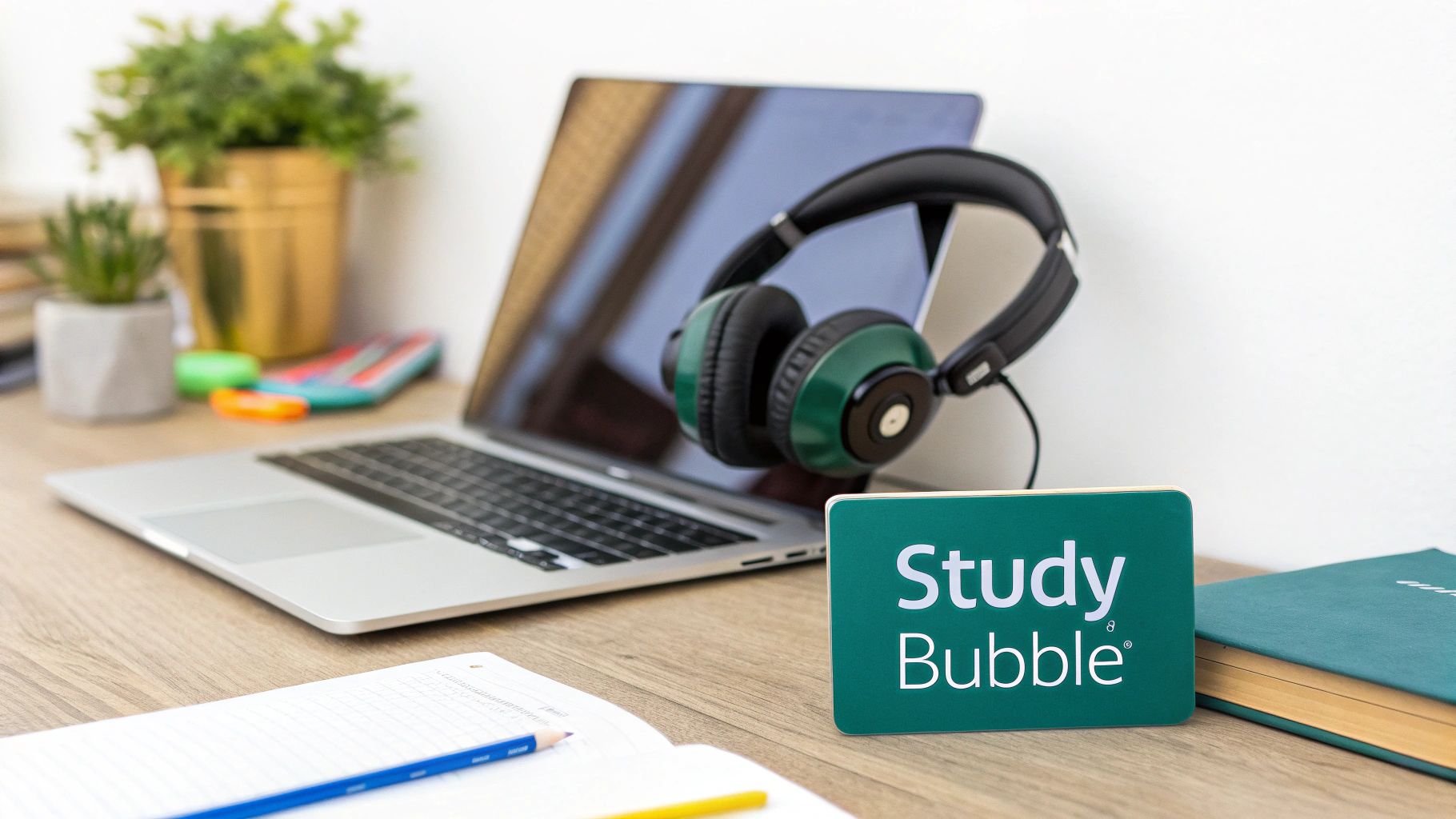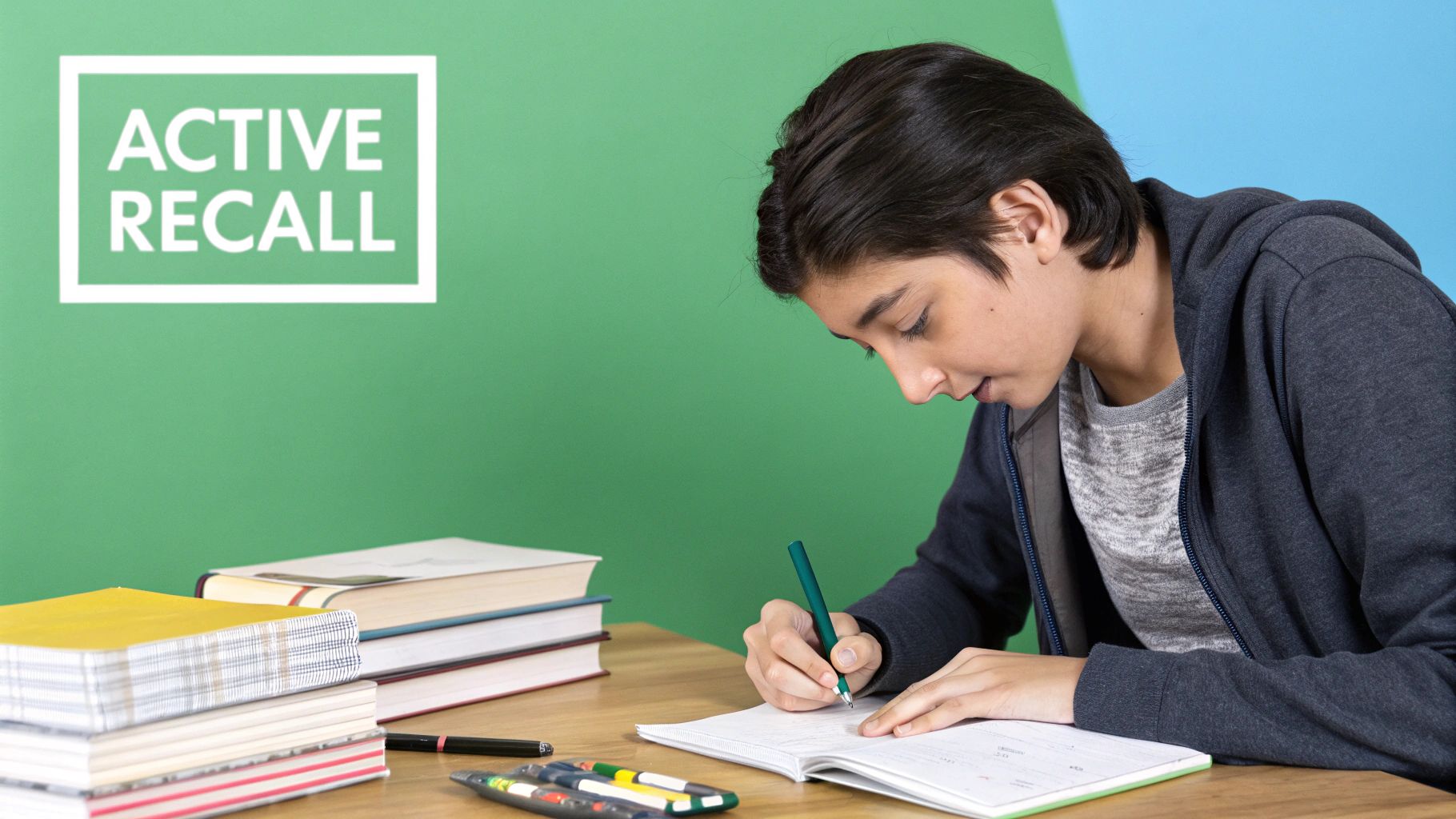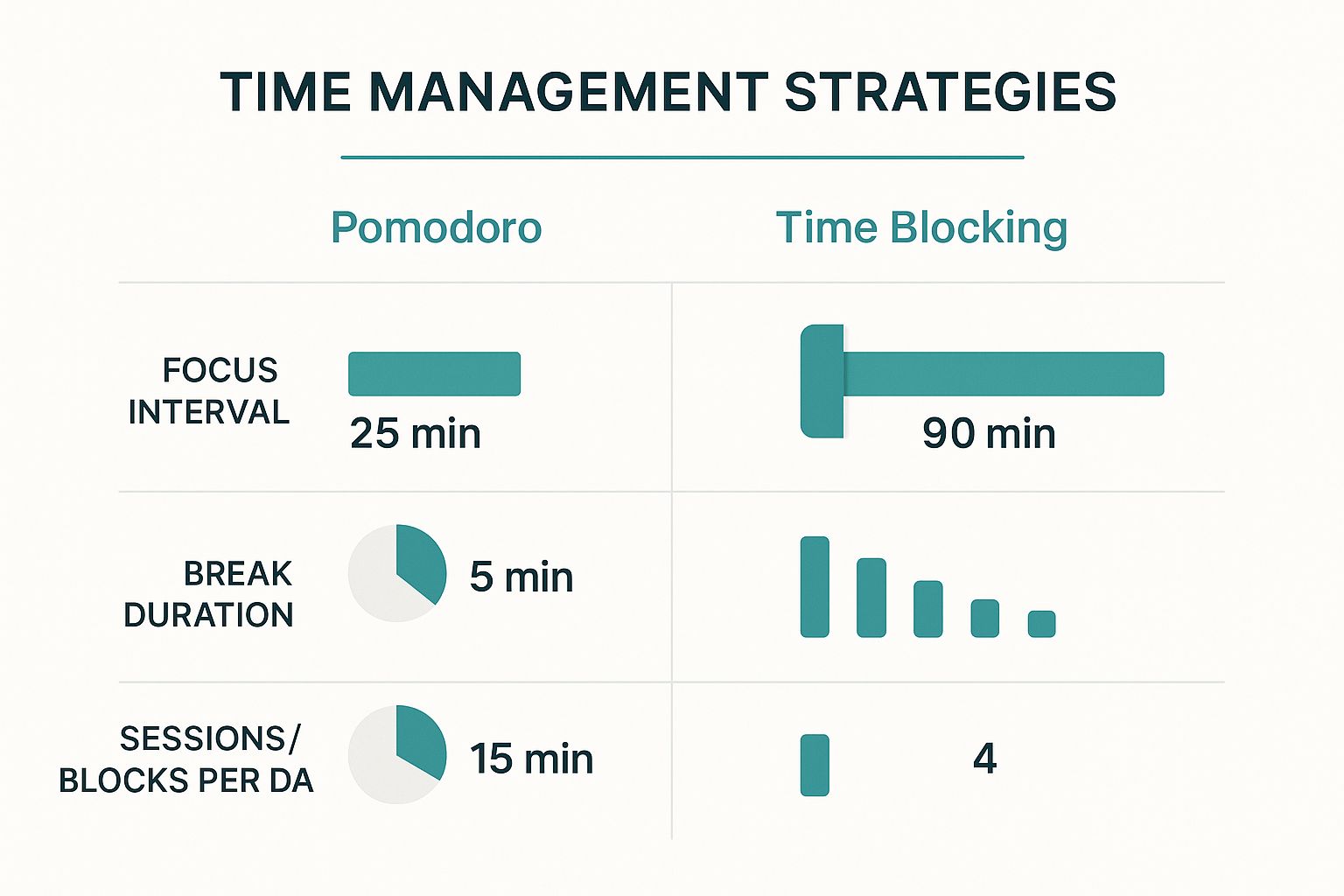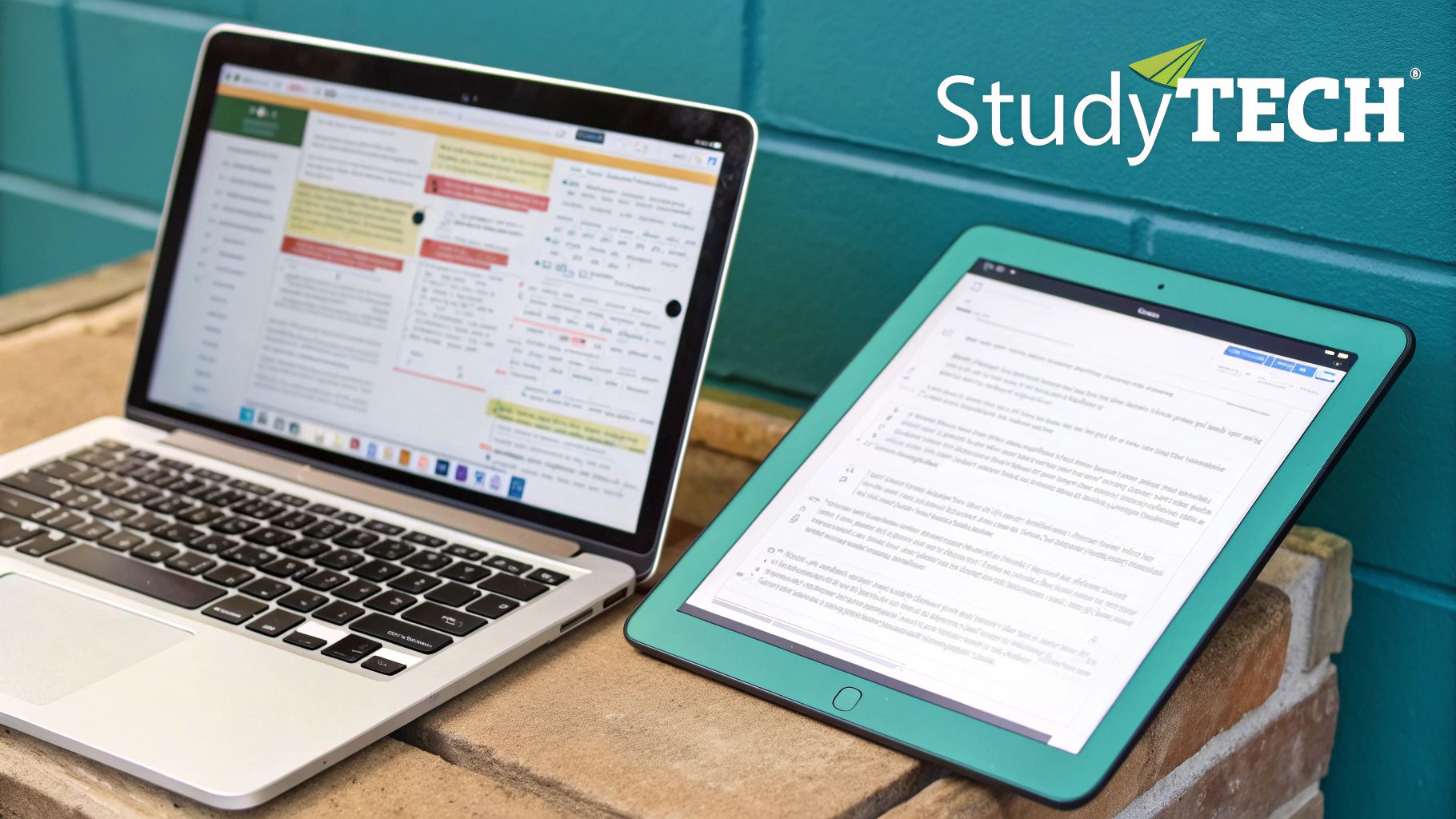Let's be honest: just putting in more hours at your desk doesn't mean you're learning more. We've all been there—staring at a textbook for hours, only to realize nothing actually sank in. The secret to making knowledge stick isn't about endurance; it's about shifting from passively rereading to active, strategic engagement.
Effective studying is a skill, not a talent. It's built on a foundation of intentional planning, deep focus, and consistent review.
Laying the Groundwork for Real Learning
So many students get caught in the "time-on-task" trap, measuring their success by the sheer number of hours they've studied. But that's a surefire recipe for burnout and mediocre results. The real game-changer is focusing on quality over quantity.
The whole idea is to make your brain work a little harder in the moment. Instead of just letting information wash over you, you need to actively retrieve it, connect it to what you already know, and apply it. This is what builds strong neural pathways, turning fragile, short-term memories into knowledge you can actually use when it counts.
Here's a quick look at the core principles that separate frustrating study sessions from productive ones.
Core Principles of Effective Studying
| Principle | Why It Matters | Quick Example |
|---|---|---|
| Active Engagement | Forces your brain to retrieve information, strengthening memory recall. | Instead of rereading notes, create a quiz for yourself from scratch. |
| Strategic Planning | Prevents cramming and burnout by breaking down large topics into manageable chunks. | Scheduling 45-minute study blocks for specific subjects throughout the week. |
| Focused Environment | Minimizes distractions that fracture attention and prevent deep concentration. | Putting your phone in another room and closing irrelevant browser tabs. |
| Consistent Review | Moves information from short-term to long-term memory through spaced repetition. | Spending 15 minutes reviewing yesterday's material before starting new content. |
These pillars don't just make studying more efficient; they make it less painful and far more rewarding.
Mindset and Environment: The Two Pillars of Success
Before you even think about specific techniques, you have to get two things right: your mindset and your environment. They are the foundation everything else is built on.
First, your mindset has to be in the right place. You have to believe you can improve and be open to trying different approaches. If you need help getting there, you can learn more about how to https://cynthiagardens.com/make-up-your-mind-to-manage-your-mind/.
Second, your surroundings send powerful cues to your brain. A messy desk, a TV droning in the background, or a phone buzzing every two minutes makes deep concentration next to impossible. You have to intentionally create a space that signals "it's time to focus."
"The difference between effective and ineffective students is not a matter of intelligence, but of adopting the right strategies. It's about working smarter, using evidence-based methods to make learning more efficient and durable."
The research is clear on this: effective study habits have a significant positive impact on academic performance. Study after study shows a direct link between proactive learning strategies and better grades, regardless of a student's background. Students who build consistent, active routines simply do better. Building that foundation is key, and exploring resources like the top study skills for high school students can give anyone aiming for success a major head start.
Designing Your Ideal Study Environment
The space you choose for studying sends powerful signals to your brain. Think about it: if your desk is buried under a mountain of clutter and your phone is constantly buzzing, your brain gets mixed messages. Is it time to work or time to get distracted? Taking control of your environment is one of the most practical things you can do to make your study sessions count.
Your surroundings have a direct, and often underestimated, impact on your ability to concentrate. When you create a space that's dedicated to learning, you're essentially giving your brain a cue that it's time for deep work. This makes slipping into that focused state of "flow" so much easier. This isn't just about finding a quiet corner; it's about intentionally building a productivity bubble, both physically and digitally.

A few small, deliberate adjustments can make all the difference. You're aiming to eliminate the friction that keeps you from starting and the distractions that pull you away once you've begun.
Crafting Your Physical Space
Let's start with your immediate workspace. Your desk should be a tool, not a storage unit. Keep only the absolute essentials within arm's reach—your textbook, a notebook, a couple of pens, and your laptop. Everything else needs a home somewhere else. This isn't just about being tidy; it's about reducing visual noise and the temptation to suddenly start organizing your paperclips.
Lighting also plays a surprisingly big role in focus. If you can, set up near a window. Natural light is a known mood and alertness booster. If you're stuck in a windowless room or studying at night, go for cool-toned LED lighting. It mimics daylight and helps you stay sharp, unlike the warm, cozy lights that tell your brain it’s time to wind down.
Your study environment should work for you, not against you. Every element, from your chair to the lighting, should be chosen with the intention of supporting deep focus and minimizing cognitive load.
Imagine you're trying to study in a noisy dorm. Creating a sanctuary feels like a lost cause, right? Not necessarily. You can build a personal "study bubble" with a good pair of noise-canceling headphones. Combine them with an app playing white noise or rain sounds, and you've effectively walled off the unpredictable chaos, giving your brain the consistent, quiet background it needs to concentrate.
Taming Your Digital World
Your digital environment is just as critical as your physical one, maybe even more so. That constant pull of notifications is one of the biggest enemies of deep work. In fact, research shows that even having your phone on your desk—face down and on silent—can significantly reduce your available brainpower. The only real solution is to create firm digital boundaries.
When it's time to study, put your phone on silent and put it in another room. The old saying "out of sight, out of mind" is neuroscience-approved. On your computer, don't rely on willpower alone. Use tools that block distracting websites for set periods.
Here are a few great options to get you started:
- Forest: A clever app that gamifies your focus time. You plant a virtual tree that grows as you work. If you leave the app to scroll Instagram, your tree withers.
- Cold Turkey Blocker: This is the heavy-duty option. It lets you block specific websites, applications, or even your entire internet connection on a schedule you set.
- AppBlock: Designed for your phone, this lets you set up different profiles to block distracting apps during your study blocks.
By consciously managing both your physical and digital spaces, you're not just cleaning up; you're building an environment that actively supports your goals. This intentional design makes it far easier to start studying and, more importantly, to stay locked in long enough to actually learn something.
Putting Active Learning Techniques Into Practice
This is where the magic happens. Moving from passively re-reading your notes to actively engaging with the material is the single biggest shift you can make for effective learning. It's the difference between temporarily holding onto facts and truly understanding how they connect.
Think of it this way: active learning forces your brain to do the heavy lifting. Instead of just letting information wash over you, you’ll be questioning it, simplifying it, and even teaching it. This effort creates stronger, more lasting memories.

It might feel harder at first, but that’s actually a great sign. That mental strain is what makes the information stick.
Simplify to Understand with the Feynman Technique
The Feynman Technique is a brilliant mental model for wrestling with complex ideas. The premise is simple: if you can't explain something in your own simple words, you don't really get it yet.
Here’s how you can use it right away:
- Pick Your Concept: Start with one topic you’re finding tricky, like the Krebs cycle or a specific historical event.
- Teach It to a Kid (Even an Imaginary One): Grab a blank sheet of paper and pretend you're explaining it to a 12-year-old. Write it all out using simple language. Avoid jargon.
- Find the Holes: You'll quickly notice where you get stuck or have to fall back on technical terms. That's your knowledge gap. Go back to your textbook or notes to shore up that specific point.
- Simplify and Refine: Rework your explanation. Cut out any complicated language and smooth it out until it’s clear, concise, and easy to follow.
For instance, you could be trying to grasp Newton's Third Law. The textbook says, "For every action, there is an equal and opposite reaction." Using the Feynman Technique, you might rephrase it: "If you punch a wall, the wall punches your hand back with the exact same force. That’s why it hurts." This makes an abstract rule feel real and intuitive.
Strengthen Your Memory with Active Recall
Active recall, or retrieval practice, is the simple act of pulling information out of your brain. It’s a workout for your memory. Every time you force yourself to remember something, you strengthen that neural pathway, making it easier to access later on.
Active recall is like exercising a muscle. The more you force your brain to retrieve a piece of information, the stronger and more accessible that memory becomes over time.
This is the complete opposite of just looking over your notes again and again. You’re not reviewing; you’re testing.
Here are a few powerful ways to practice active recall:
- Flashcards: A classic for a reason. Use physical cards or an app like Anki or Quizlet. The crucial step? Say the answer out loud before you flip the card.
- The "Brain Dump": After reading a chapter, close the book. Write down everything you can remember about it—key ideas, formulas, dates, anything. Then, open the book and see what you missed.
- Practice Problems: For subjects like math, chemistry, or physics, this is non-negotiable. Do the problems at the end of the chapter without peeking at the solution manual first.
Lock in Learning with Spaced Repetition
Spaced repetition is the perfect partner for active recall. It’s designed to combat the "forgetting curve"—our natural tendency to forget things over time. By reviewing material at increasingly longer intervals, you interrupt the forgetting process and drive information into long-term storage.
A typical schedule for a new concept might look something like this:
- Day 1: Review it right after you learn it.
- Day 2: Look at it again the next day.
- Day 4: Check back in a few days.
- Day 8: Revisit it a week later.
Each review solidifies the memory. This approach is worlds more effective than a last-minute cramming session. Getting into these habits early is a game-changer. Research shows that students who use structured study techniques experience significantly better academic performance and lower stress, helping them avoid the burnout that often comes with cramming. You can find more strategies for building these routines and see why they are a key predictor of success in the 2025 educational guides.
Choosing Your Time Management Strategy
Knowing how to study with active learning is a game-changer, but it's only half the battle. The other, equally critical piece of the puzzle is managing your time. A great study plan isn't just about what you do; it's about when you do it and for how long.
Without a solid strategy, it's all too easy to get overwhelmed, procrastinate, and fall back on those last-minute cram sessions that we all know don't lead to long-term learning.
This is where specific time management methods can save the day. They give you the framework to turn your good intentions into consistent, productive habits. The idea is to work in focused bursts, protect your mental energy, and make sure downtime is a non-negotiable part of your schedule, not just a leftover.
The Power of Sprints with the Pomodoro Technique
Do you ever sit down to study, only to find your mind wandering after a few minutes? If you struggle with focus or procrastination, the Pomodoro Technique might be exactly what you need. It’s built on the idea of working in short, intense sprints.
The structure is brilliantly simple:
- You work on a single task for a 25-minute interval. No phone, no distractions.
- When the timer goes off, you take a short 5-minute break. Get up, stretch, grab some water.
- After four of these "Pomodoros," you take a longer, more substantial break of 15-30 minutes.
This method makes even the most daunting tasks feel manageable because you're only ever committing to 25 minutes of focus at a time. It also forces you to take those crucial breaks that prevent burnout and keep your mind fresh.
Building a Structured Week with Time Blocking
If you're someone who likes to see the big picture of your week, Time Blocking is a fantastic approach. Instead of working from a simple to-do list, you actually schedule every part of your day directly into your calendar. This means blocking out time for classes, study sessions, meals, workouts, and even free time.
Think of a student-athlete juggling a packed schedule. They might block out 6-8 AM for practice, 9 AM-1 PM for classes, and then schedule specific 90-minute study blocks for different subjects throughout the afternoon. By also scheduling in dinner with friends or an hour to watch a show, they treat their rest with the same importance as their responsibilities.
Time management isn't about finding more hours in the day. It's about being intentional with the hours you have. Both the Pomodoro Technique and Time Blocking are tools to help you do just that, each in its own way.
Deciding between these methods often comes down to personal preference and the nature of your work.
Choosing Your Time Management Method
To help you decide, here’s a quick breakdown of some popular methods. Think about your own study habits and which approach feels like the most natural fit.
| Method | Best For | How It Works |
|---|---|---|
| Pomodoro Technique | Students who get distracted easily or feel overwhelmed by large tasks. | Work in focused 25-minute sprints, followed by 5-minute breaks. Take a longer break after four cycles. |
| Time Blocking | Students with complex schedules or those who prefer a highly structured plan for their entire day or week. | Assign a specific time slot in your calendar for every task, including study, leisure, and meals. |
| The Eisenhower Matrix | Students who struggle with prioritization and spend too much time on non-essential tasks. | Categorize tasks into four quadrants based on urgency and importance: Do, Decide, Delegate, Delete. |
No matter which method you lean toward, the key is consistency. Try one for a week and see how it feels. You might even find that a hybrid approach works best for you.
This visual comparison really drives home the difference between the sprint-based Pomodoro and the schedule-based Time Blocking.

As the infographic shows, Pomodoro is all about rapid, repeated bursts of focus, whereas Time Blocking is for setting aside longer, dedicated work periods.
Many students get the best results by combining them. For example, you could use time blocking to map out your week, and then use the Pomodoro Technique within those study blocks to stay locked in.
The best method is the one you’ll actually stick with. For more great ideas on mastering your schedule, you can get some expert tips to help you take back your time.
Using Technology To Study Smarter, Not Harder
Technology often gets a bad rap as the ultimate distraction, but let’s be honest—when used right, it can be your most powerful study partner. The real trick is shifting from mindless scrolling to mindful application. It's about turning the devices you already have into tools that make your study sessions more effective.
Instead of fighting it, let’s make technology work for you. The goal is to weave digital tools into your study habits so seamlessly they feel like a natural extension of your brain, helping you organize, review, and even collaborate better than ever.

It all comes down to choosing apps that enhance your focus, not splinter it.
Digital Tools for Active Learning
The right apps can seriously level up your study game. For taking notes that actually make sense later, tools like Notion or Obsidian are fantastic. They let you do more than just type out lectures; you can create a personal wiki, linking ideas and building a web of knowledge that grows as you learn.
And for active recall? Digital flashcards are a game-changer. Anki, for example, uses a smart spaced repetition algorithm. It figures out which concepts you're struggling with and shows them to you more often, right before you're about to forget them. It automates the whole process, making long-term retention so much easier. As you build your digital toolkit, finding apps that complement traditional methods is key. It's worth exploring the best reference manager for annotations and note-taking to really get your workflow dialed in.
Your phone and laptop can either be your biggest liability or your greatest asset during study time. The choice comes down to which apps you open and how you use them.
We've been doing our own experiments, too, putting the latest tech to the test to see what really makes a difference.
Navigating the Rise of AI Tutors
There's no denying it: AI tools have completely changed how students study. A recent global survey found that a staggering 80% of undergraduates across 15 countries have used generative AI to help with their studies. But that doesn't mean everyone is sold—53% of those same students worry about the accuracy of the information they get from AI. You can dig into the complete global student experience findings to see the full picture.
To use these tools without falling into the accuracy trap, treat AI as a starting point, never the final answer.
- Brainstorming partner: Ask an AI to generate practice questions on a topic or to explain a complex idea in a simpler way. It’s great for getting unstuck.
- Fact-check everything: Always, always cross-reference what an AI tells you with your textbook, lecture notes, or other trusted sources.
- Never copy-paste: Use AI to understand a concept better, then close the tab and write your own answer in your own words.
By using these digital resources wisely, you can make your study sessions more dynamic, personalized, and—most importantly—more effective.
Your Top Study Questions, Answered
Even the best study plan hits a snag now and then. In my experience, knowing how to handle the common roadblocks is just as important as having a good strategy in the first place. Let’s walk through some of the questions I hear most often from students.
Think of these as quick, practical fixes to fine-tune your approach and keep you moving forward with confidence.
How Much Should I Actually Study Every Day?
This is probably the biggest myth in all of academia. We're conditioned to think that more hours automatically equals better grades, but it's just not true. The real goal is quality over quantity.
Instead of aiming for a six-hour marathon session of passively re-reading your notes, shoot for 2-4 hours of highly focused, active learning. This is where techniques like the Pomodoro method really shine—those short, intense bursts of concentration are far more effective than long, drawn-out sessions that just lead to burnout.
I've seen it time and time again: the best students don't necessarily study more than everyone else, they just study more intentionally. They know that one 45-minute active recall session is worth more than three hours of mindlessly highlighting a textbook.
When you prioritize deep work, you'll be surprised how much you can accomplish in less time. That frees you up for the rest and downtime your brain needs to actually consolidate those long-term memories.
If I Could Only Use One Study Technique, What Should It Be?
Hands down, if you're going to master a single strategy, make it active recall. From a purely evidence-based standpoint, it’s one of the most powerful ways to transfer information from your short-term memory into your long-term storage.
At its core, active recall is just the act of deliberately pulling information out of your brain. This simple act of retrieval strengthens the neural pathways for that information, making it easier to recall later. You’re not just reviewing; you're actively testing yourself, which forces your brain to work a little harder and makes the information stick.
It’s easy to start using active recall right away with a few basic tools:
- Flashcards: The old-school classic. Whether you use paper cards or a digital app, the trick is to say the answer out loud before you flip it over. This makes it a real retrieval attempt, not just a recognition exercise.
- Self-Quizzing: Finished a chapter? Close the book and grab a blank sheet of paper. Write down everything you can remember. This kind of "brain dump" is a fantastic way to see what you actually know versus what you think you know.
How Do I Finally Stop Procrastinating?
Procrastination almost always boils down to one thing: feeling overwhelmed. The task just seems too big, so we don't even start. The fix? Make the first step so ridiculously small that it feels silly not to do it.
A great psychological trick for this is the "two-minute rule." The idea is simple: if starting a task takes less than two minutes, just do it now. Read one page. Open the document. Write the first sentence. That small action creates momentum.
For bigger projects, your best defense is breaking them down into the smallest possible chunks on your study schedule. Checking off those tiny, manageable tasks gives you a little hit of dopamine and a sense of accomplishment, which in turn fuels your motivation to keep going. A structured schedule removes the guesswork and turns studying from a dreaded, monumental task into a simple, consistent habit.
At Cynthia Gardens, we know that a quiet, comfortable home makes all the difference for academic success. Our serene apartments near FAU provide the perfect backdrop for focused studying. Discover your ideal study sanctuary at Cynthia Gardens and set yourself up for your best year yet.
